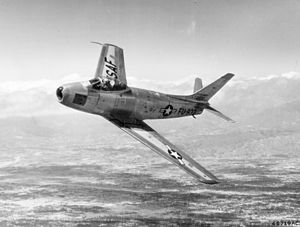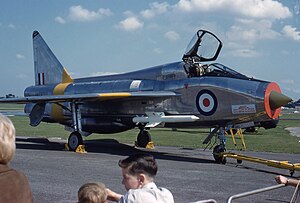John Nicholls
Sir John Moreton Nicholls KCB CBE DFC AFC (born July 5, 1926 in Moreton , Cheshire - † May 17, 2007 ) was a British Air Force officer in the Royal Air Force , who last served in the rank of Lieutenant General ( Air Marshal ) between 1979 and 1980 Chief of the Air Force ( Vice Chief of the Air Staff ) was.
Life
Pilot training and Korean war

Nicholls began after his school education at the Liverpool Collegiate School to study at St Edmund Hall of the University of Oxford . During this time he already took part in pilot courses of the Air Training Corps (ATC) and joined the RAF in June 1945. After completing his aviation training, he was promoted to a temporary soldier ( Short Service Commission ) on June 14, 1946 with a commitment period of 4 years and to a lieutenant ( pilot officer ). Shortly thereafter, he became a pilot of with Supermarine Spitfire - fighters equipped No. 28 Squadron RAF , which was stationed in the Far East . Squadron commander was shortly afterwards Flight Lieutenant Ivor Broom , an award-winning pilot of the RAF Bomber Command during the Second World War and later also an Air Marshal. On June 14, 1947, he was promoted to first lieutenant ( Flying Officer ) and on August 16, 1948 as a professional soldier ( Permanent Commission ) in the RAF.
After his return to Great Britain, Nicholls began in September 1949 a pilot course for the Gloster Meteor , the jet-powered British fighter plane that was ready for action. After his subsequent promotion to captain ( Flight Lieutenant ) on December 14, 1949, he became a flight instructor at No. 257 Squadron RAF and then a pilot at the Central Fighter Establishment (CFE ). He then completed a supplementary course on the North American F-86 fighter plane at Nellis Air Force Base , one of the largest air force bases in the US Air Force, between April and June 1952 . After completing his training, he was assigned to the 335th Fighter Squadron USAF as a pilot of the North American F-86 during the Korean War . In this role he flew around 100 sorties from Gimpo Airport near Seoul during the Korean War and damaged, among other things, two Mikoyan-Gurevich MiG-15 fighter aircraft during an aerial battle over the Yalu . Eventually he destroyed another MiG-15 during its 99th mission in an air-to-air combat, thereby becoming the first RAF pilot to destroy a MiG. He flew his last mission in the Korean War on December 9, 1952 and was awarded the Distinguished Flying Cross (DFC) on June 2, 1953 and the US Distinguished Flying Cross on October 30, 1953 for his military service during the war .
Uses as a staff officer

After serving as aviation commander of a squadron, Nicholls became a tactics teacher at the Fighter Leader's School (FLS) in 1953 and worked there for five years. During this time he was promoted to Major ( Squadron Leader ) on July 1, 1956 and took part between May 1958 and June 1959 in another exchange program with the US Air Force at the 435th Fighter Squadron USAF and 83rd Fighter Squadron USAF . He then became a liaison officer for the Air Raid Command ( RAF Fighter Command ) at aircraft manufacturer English Electric , where he was involved in the development of the new twin- engine interceptor English Electric Lightning .
After his promotion to Lieutenant Colonel ( Wing Commander ) on July 1, 1961, Nicholls took over on April 2, 1962 his first command post, as a commanding officer ( Air Fighting Development Squadron ). In this role he played a key role in the development of the armament of the English Electric Lightning (EEL), for example by flying a Supermarine Spitfire fighter plane in an unusual mock dogfight against an EEL. After attending a course at the United Staff Academy JSSC ( Joint Services Staff College ) in 1964, he became a staff officer at the Air Secretary in the Air Ministry on October 12, 1964, and then on April 15, 1965, deputy head of the mission briefing of the Air Staff Briefing . In the meantime, on January 1, 1965, he was awarded the Air Force Cross (AFC) for his aviation services .
On July 1, 1966, Nicholls was promoted to Colonel ( Group Captain ) and took over on June 9, 1967 as the successor to Group Captain Arthur Strudwick as commander of the RAF Leuchars Air Force Base . On June 13, 1970 he was appointed Commander of the Order of the British Empire (CBE). After his promotion to Air Commodore on July 1, 1970, he completed a course at Imperial Defense College (IDC) in London . After graduation on January 18, 1971, he became Senior Air Staff Officer (SASO) Chief of Staff of No. 11 (Fighter) Group RAF and then on November 22, 1971 Personal Staff Officer of the Chief of the Defense Staff , Admiral of the Fleet Peter Hill-Norton .
Promotion to Air Marshal and retirement
On July 1, 1973, Nicholls was promoted to Major General ( Air Vice Marshall ) in this use . Almost four months later, on October 31, 1973, he became Chief of Staff (SASO) of the RAF Strike Command . He then returned to the Ministry of Defense on March 20, 1976, where he became Assistant Chief of the Air Staff for Operational Requirements .
Nicholls then succeeded Air Marshal Alasdair Steedman on September 28, 1977 as Air Member for Supply and Organization on the Air Force Board of the Department of Defense and remained in this position until he was replaced by Rex Roe on December 1, 1978. During this time he was promoted to Lieutenant General ( Air Marshal ) himself on January 1, 1978 . In addition, he was beaten on June 3, 1978 to Knight Commander of the Order of the Bath (KCB) and from then on carried the suffix "Sir".
Most recently, Nicholls was on January 30, 1979 Vice Chief of the Air Staff and thus Air Marshal Peter Terry . He held this office until his replacement by Air Marshal David Craig on May 3, 1980. On July 31, 1980, he finally retired from active military service.
After his retirement, Nicholls, who was also a Companion of the Chartered Management Institute (CCMI), became director and representative of the aircraft manufacturer British Aerospace in Saudi Arabia in 1980 . However, he had to give up this activity in 1982 after he became seriously ill. Most recently, since 1993, he was a board member of the National Health Service (NHS Trust) James Paget Hospital in Gorleston-on-Sea .
Nicholls was married twice. His first marriage was Enid Rose in 1946, who died in 1975. From this marriage two daughters were born. His second marriage to Sheelagh Hall in 1977 remained childless.
Web links
- Biography on Air of Authority - A History of RAF Organization
- Air Marshal Sir John Nicholls . In: The Daily Telegraph, May 21, 2007
Individual evidence
- ^ London Gazette (Supplement). No. 37642, HMSO, London, July 9, 1946, p. 3489 ( PDF , accessed March 9, 2016, English).
- ^ London Gazette (Supplement). No. 38547, HMSO, London, March 1, 1949, p. 1049 ( PDF , accessed March 9, 2016, English).
- ↑ London Gazette . No. 39879, HMSO, London, June 2, 1953, p. 3115 ( PDF , accessed March 9, 2016, English).
- ^ London Gazette (Supplement). No. 39999, HMSO, London, October 30, 1953, p. 5768 ( PDF , accessed March 9, 2016, English).
- ^ London Gazette (Supplement). No. 43529, HMSO, London, January 1, 1965, p. 34 ( PDF , accessed March 9, 2016, English).
- ^ RAF Leuchars Station Commanders on Air of Authority - A History of RAF Organization
- ^ London Gazette (Supplement). No. 45117, HMSO, London, June 13, 1970, p. 6371 ( PDF , accessed March 9, 2016, English).
- ^ Air Member for Supply and Organization on Air of Authority - A History of RAF Organization
- ^ London Gazette (Supplement). No. 47549, HMSO, London, June 3, 1978, p. 6230 ( PDF , accessed March 9, 2016, English).
- ↑ Vice Chief of the Air Staff on Air of Authority - A History of RAF Organization
| personal data | |
|---|---|
| SURNAME | Nicholls, John |
| ALTERNATIVE NAMES | Nicholls, Sir John Moreton (full name) |
| BRIEF DESCRIPTION | British Air Force officer in the United Kingdom |
| DATE OF BIRTH | July 5, 1926 |
| PLACE OF BIRTH | Moreton , Cheshire |
| DATE OF DEATH | May 17, 2007 |